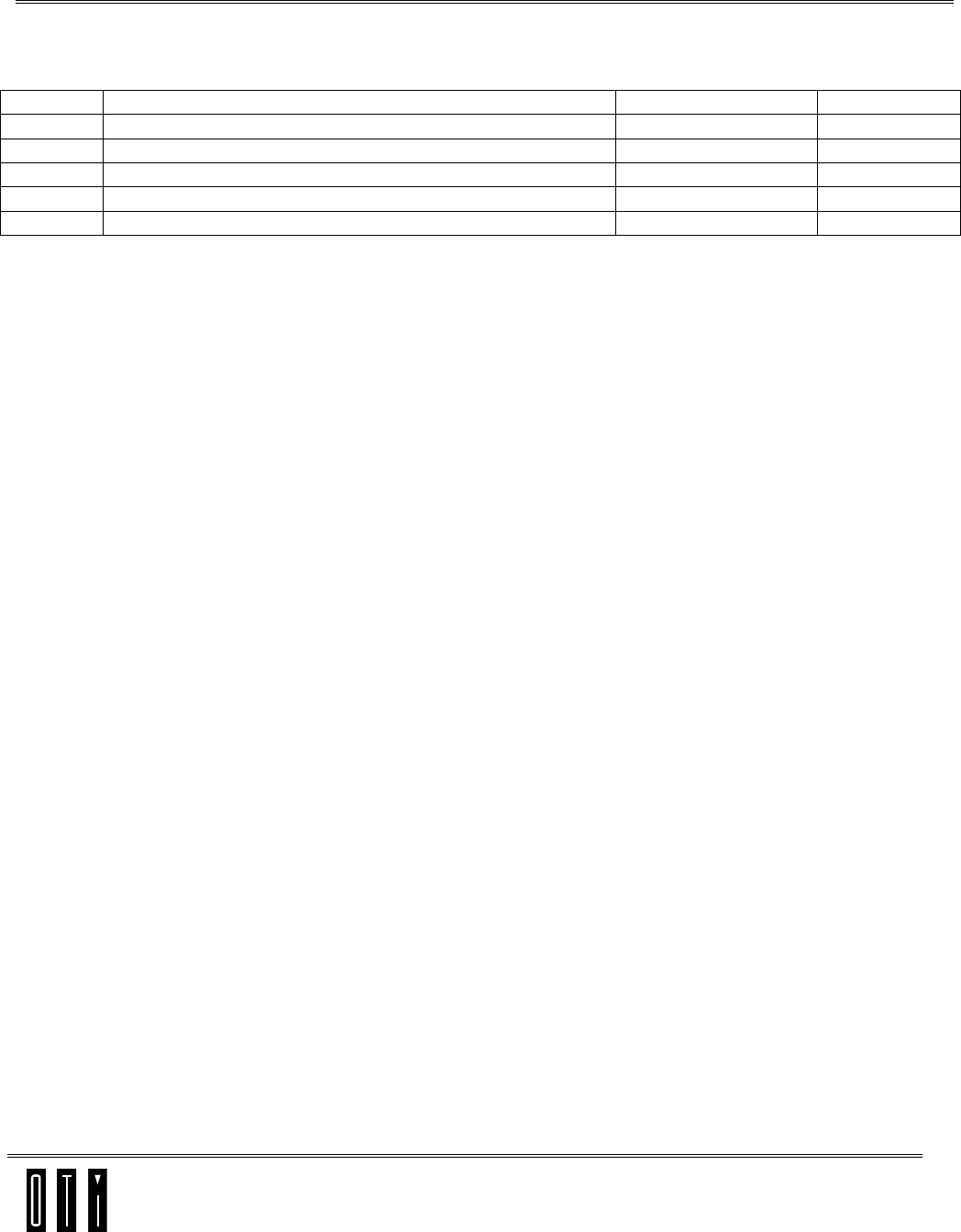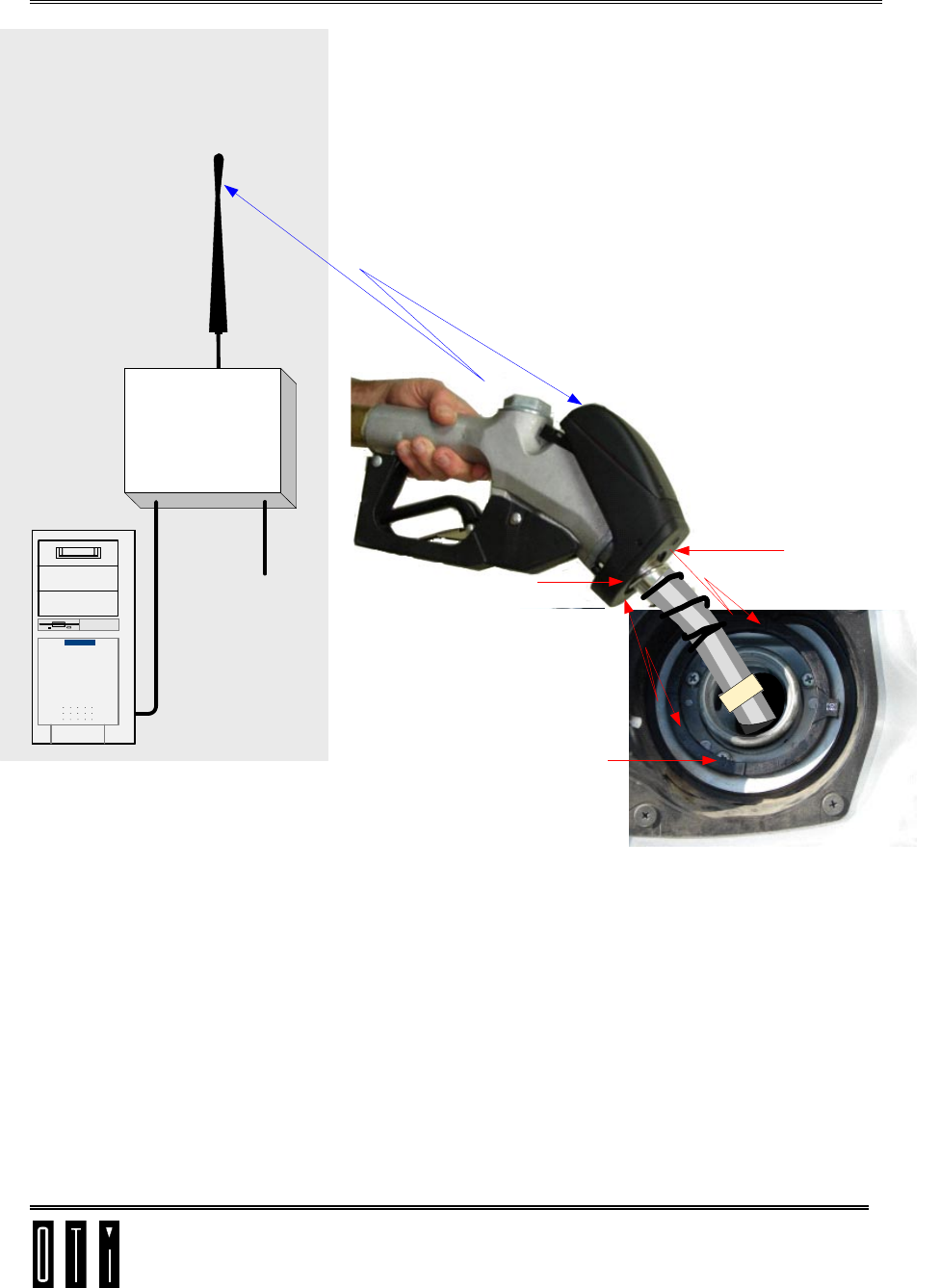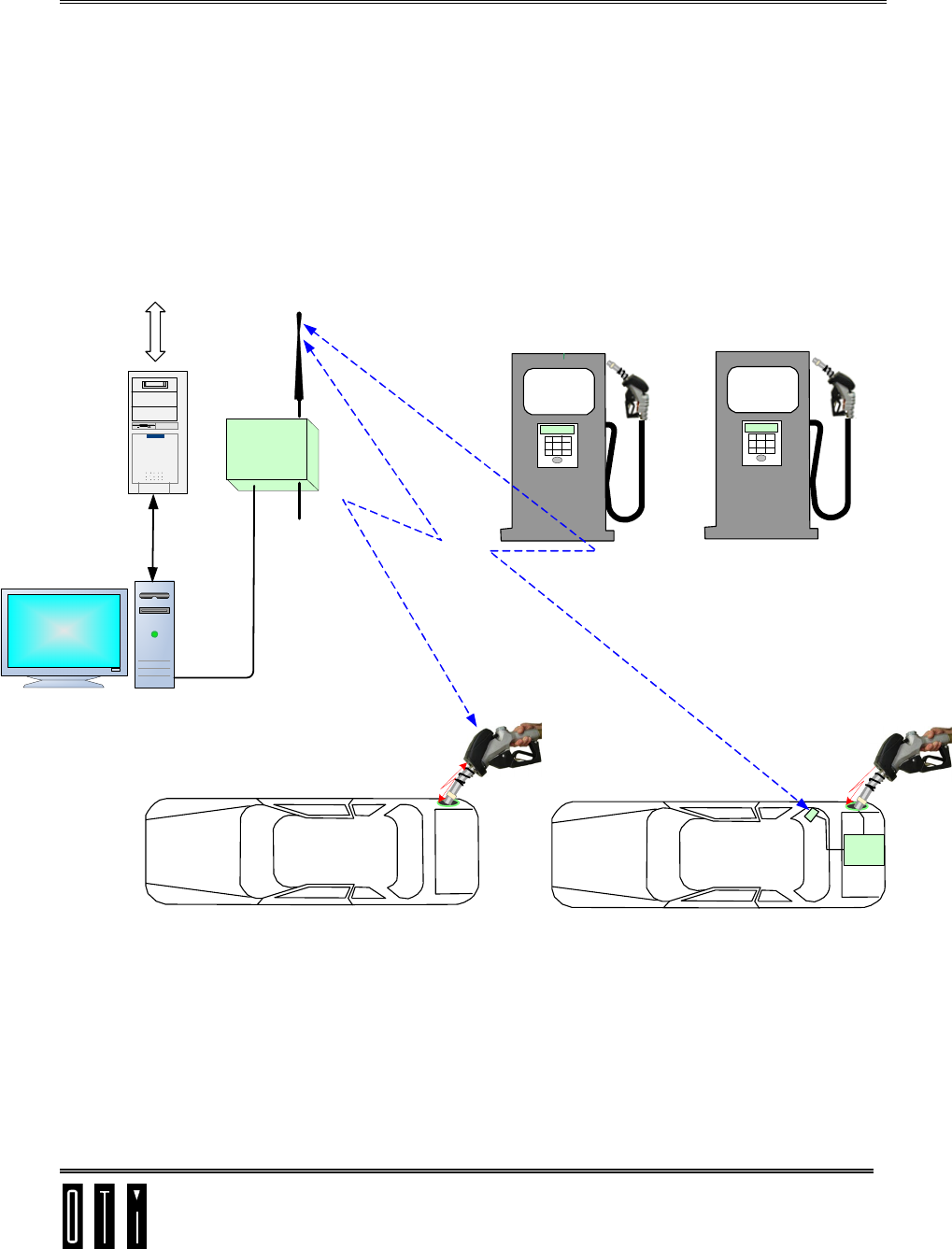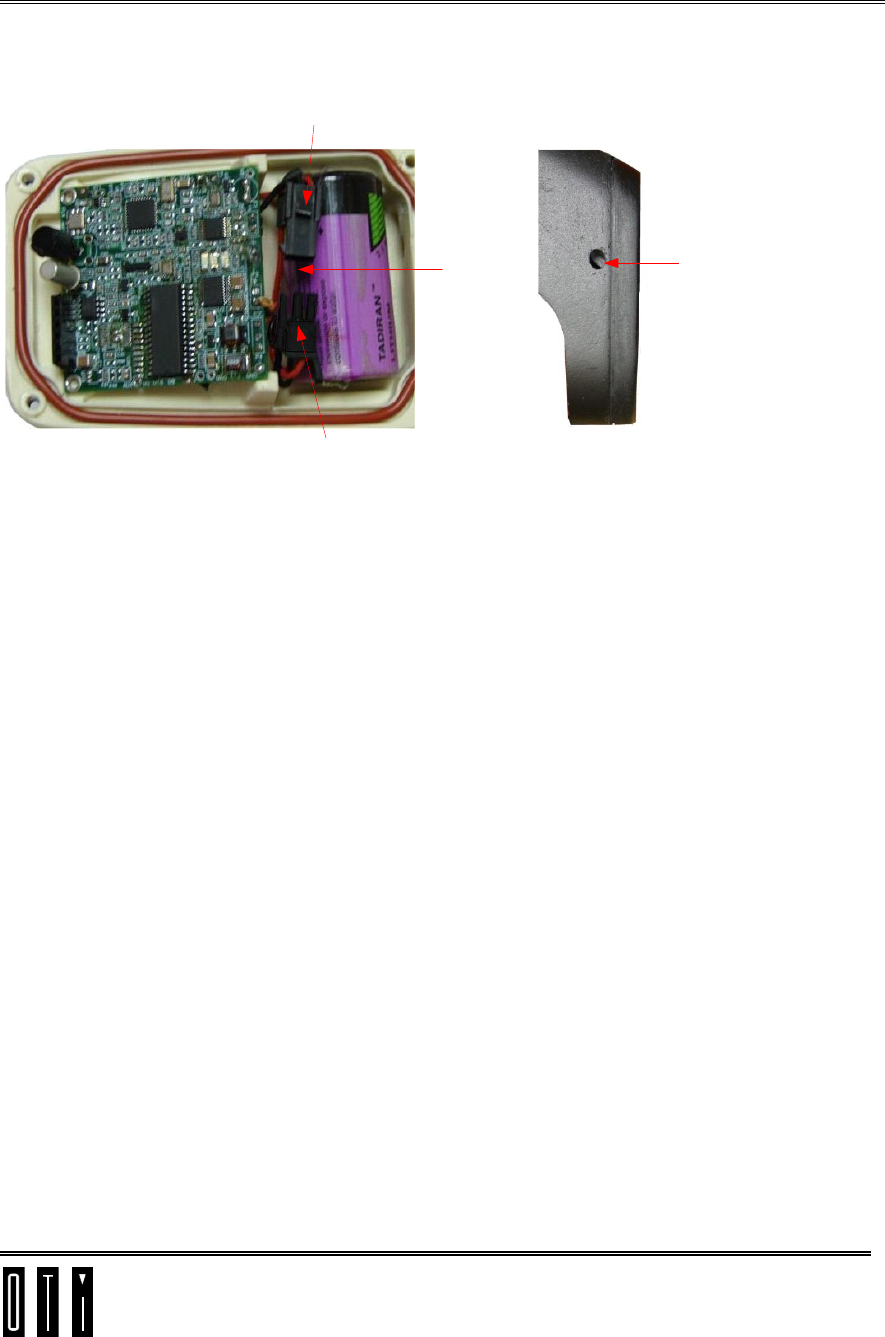On Track Innovations OTI-EFPRFN900 SC transceiver-RFID transceiver-NID transmitter of RF Nozzle reader User Manual User manual 20581
On Track Innovations Ltd SC transceiver-RFID transceiver-NID transmitter of RF Nozzle reader User manual 20581
manual

Confidential & Proprietary
Version 2.01
Easy Fuel Plus
RF Nozzle
User Manual

Easy Fuel Plus Rf Nozzle Version 2.01
Revision History
Confidential & Proprietary Page A
Revision History
Version Description Date Author
1.00 First draft 2 April 2008 Avner
1.01 Added EF-VID support 3 April 2008 Avner
2.00 Major revision 18 March 2010 Avner
2.01 Minor revisions 23 March 2010 Avner & Hemy
2.01` Minor revisions 14 April 2010 Hemy
NOTICE
This manual contains intellectual property, including but not limited, to trade secrets
and know-how, operation procedures and production procedures that belong solely to
OTI. Disclosure and/or use and/or reproduction of any part of the above are strictly
forbidden, except under a written license from OTI.

Easy Fuel Plus Rf Nozzle Version 2.01
FCC Compliance
Confidential & Proprietary Page B
FCC Compliance
This device (RF nozzle model EFP-RFN900) complies with Part 15, of the FCC Rules.
Operation is subject to the following two conditions:
1. This device may not cause harmful interference, and
2. This device must accept any interference received, including interference that may
cause undesired operation
NOTE: This equipment has been tested and found to comply with the limits for a Class B
digital device, pursuant to part 15 of the FCC Rules. These limits are designed to provide
reasonable protection against harmful interference in a residential installation. This
equipment generates, uses and can radiate radio frequency energy and, if not installed and
used in accordance with the instructions, may cause harmful interference to radio
communications.
However, there is no guarantee that interference will not occur in a particular installation.
If this equipment does cause harmful interference to radio or television reception, which
can be determined by turning the equipment off and on, the user is encouraged to try to
correct the interference by one or more of the following measures:
• Reorient or relocate the receiving antenna.
• Increase the separation between the equipment and receiver.
• Connect the equipment into an outlet on a circuit different from that to which the
receiver is connected.
• Consult the dealer or an experienced radio/TV technician for help.
Changes or modifications in this equipment, not expressly approved by the party
responsible for compliance (On Track Innovations Ltd,) could void the user’s
authority to operate the equipment.
FCC ID: JNX-OTI-EFPRFN900
Responsible Party:
OTI America
Suite 105
111 Wood Ave. South
Iselin, NJ 08830, USA
Tel: +1-732-429-1900, Fax: +1-732-429-1960
info@otiamerica.com

Easy Fuel Plus Rf Nozzle Version 2.01
Table of Contents
Confidential & Proprietary Page C
Table of Contents
REVISION HISTORY .................................................................................................................................................................A
NOTICE ........................................................................................................................................................................................A
FCC COMPLIANCE ...................................................................................................................................................................B
TABLE OF CONTENTS .............................................................................................................................................................C
1
INTRODUCTION ................................................................................................................................................................1
2.
EFP RF NOZZLE.................................................................................................................................................................2
2.1
PRODUCT DESCRIPTION...................................................................................................................................................2
2.2
PRODUCT FEATURES.......................................................................................................................................................2
2.3
OPERATIONAL SCENARIOS..............................................................................................................................................3
3.
INSTALLATION..................................................................................................................................................................5
3.1
BATTERY CONNECTION ..................................................................................................................................................5
3.2
MOUNTING .....................................................................................................................................................................5
3.3
INITIALIZATION...............................................................................................................................................................5

Easy Fuel Plus Rf Nozzle Version 2.01
Introduction
Confidential & Proprietary page 1
1 Introduction
EFP (EasyFuel Plus) is an automated refueling system based on wireless
communication between the system components.
The system utilizes 13.56MHz proximity technology for interfacing between the
vehicle and the fuel dispenser and longer range UHF communication for wireless
interfacing to the EF Site Controller which is mounted in the site office
The new RFN (RF Nozzle) unit, together with the new EF passive RFID vehicle tag, is
OTI's latest addition to the EFP Family which also includes:
EF-SC (Site Controller)
The Site Controller is an RF transceiver, mounted in the site office, serving as
an interface between the EFP system and the station refueling control system. It
operates at 433MHz or 902-928MHz frequency ranges, depending on the
locally allocated frequency slots.
EF-VID (Vehicle IDentification) vehicle tag
The VID is a microcontroller based in-vehicle device, utilizing vicinity range
receiver for reading the NID (Nozzle IDentification) signal and UHF
transceiver for communication with the Site Controller. It communicates to the
SC the combined information of the vehicle data and the nozzle ID so as to
enable proper refueling control. The vehicle data may include more
sophisticated data elements like the odometer reading. The EF VID derives its
power from the vehicle battery.
NID (Nozzle IDentification)
The NID is a self-contained, battery operated, very low power 13.56MHz RF
transmitter that slips over the fuel nozzle spout. The NID identifies the nozzle
ID to the VID.
Passive RFID vehicle tag
The new passive RFID vehicle tag enables the RFN to read the vehicle basic ID
information and to transfer the combined information of the vehicle and the
nozzle ID data to the SC so as to enable proper refueling control. This way the
use of VID may be avoided unless more sophisticated vehicle information is
required as mentioned above.

Easy Fuel Plus Rf Nozzle Version 2.01
EFP RF Nozzle
Confidential & Proprietary page 2
2. EFP RF Nozzle
2.1 Product description
The RFN (RF Nozzle) is mounted on the refueling nozzle and serves as an
interface between the refueled vehicle and the station SC (Site Controller) to
facilitate controlled and secured refueling. It is a battery powered unit,
comprising three different transceivers:
RFID 13.56MHz transceiver: Communicate with passive RFID vehicle tag.
NID 13.56MHz transmitter: Transmit the nozzle ID to the VID vehicle tag.
SC UHF transceiver: Communicate with the SC.
All the transceivers operate under the control of a local microprocessor.
2.2 Product Features
Bi-directional proximity 13.56MHz interface with passive RFID vehicle
tags according to ISO15693 Vicinity cards standard.
Unidirectional proximity 13.56MHz interface to VID vehicles tags.
Long range UHF interface to the Site Controller.
Flexible, software configurable microprocessor based design.
Compliance with FCC Section 15 Radio requirements.
Compliance with IEC/EN60079-1 & IEC/EN60079-11 safety
requirements for operation in Hazardous area.
Operating temperature range -20° to +60°C (-4° to 140°F).
Powered by replaceable Lithium battery.
Quick and simple installation.

Easy Fuel Plus Rf Nozzle Version 2.01
EFP RF Nozzle
Confidential & Proprietary page 3
SC
Site Controller
Host
230/110
VAC
UHF communication
(433/902-928MHz)
Site Office
RS232/485
RF Nozzle Vehicle
RF
Unit
Nozzle
RFID Antenna
13,56
MHz
Vehicle Fuel Inlet
NID Antenna
Passive RFID Vehicle Tag or
FIC (Fuel inlet Coil)
FIC
TAG
Figure 2-1: RF Nozzle System Block Diagram
2.3 Operational Scenarios
Vehicle with passive RFID tag:
When the nozzle is inserted into the vehicle refueling inlet the RFN reads data from the
passive RFID vehicle tag and transmits it together with its own identity to the site
controller. Fuel is dispensed once the transaction is authorized. Fuel is dispensed as
long as the RF Nozzle detects the presence of the passive RFID tag. If the nozzle is
retracted from the refueling inlet so that the RFID tag is not detected the RFN informs
the system to stop dispensing fuel.

Easy Fuel Plus Rf Nozzle Version 2.01
EFP RF Nozzle
Confidential & Proprietary page 4
Vehicle with VID vehicle tag:
When the nozzle is inserted into the vehicle refueling inlet the RF nozzle periodically
transmit its NID to the VID which transmits it together with its own identity to the site
controller. Fuel is dispensed once the transaction is authorized. Fuel is dispensed as
long as the VID detect the NID signal from the RFN (or the NID). If the nozzle is
retracted from the refueling inlet so that the NID signal is not detected, the VID informs
the system to stop dispensing fuel.
UHF
Antenna
RFID Tag
EFP
VID
Site
Controller
230/110
VAC
RS232/
485
Pump Controller
Transactions Uploaded to
Back office
POS Software
EFP Passive RFID Vehicle Tag EF - VID
RFN
FIC
RFN
RFNRFN
NID
Antenna
RFID
Antenna
UHF UHF
Figure 2-2: Data Communication Flow Options

Easy Fuel Plus Rf Nozzle Version 2.01
Installation
Confidential & Proprietary page 5
3. Installation
Battery connector
RFN connector
Connector
niche
Two RFN locking screws
(one on each side)
Figure 3-1: Installation
3.1 Battery Connection
The RFN unit is supplied with the battery connector disconnected. To connect the
battery open the four cover screws, remove the RFN top cover and connect the battery
connector to the RFN connector.
After connection stuff the connectors into the niche by the battery, return the RFN top
cover and close the four cover screws.
Note: The male and the female parts of the two pin battery connectors are interlocked
to avoid reverse connection. If mating is resisted - reverse direction and try again. To
disconnect the battery make sure to press the lever on the battery connector before
pulling the connectors apart.
3.2 Mounting
Insert the fuel nozzle spout through the RFN ring and saddle it on the fuel nozzle base.
Use 2mm Allen key to close the two RFN locking screws and lock the RFN firmly in
place.
3.3 Initialization
For proper field operation the RFN firmware needs to be configured with few
parameters associated with the specific installation. The most important parameter is an
ID number associated with the specific nozzle it is mounted on. The configuration is
performed utilizing a special HHT (Hand Held Terminal) device. The detailed
procedure is contained in the user manual of the HHT.